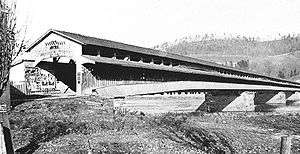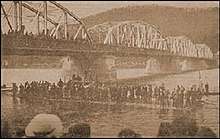Jay Street Bridge
The Jay Street Bridge crosses the West Branch Susquehanna River between Lock Haven on the south bank and Lockport on the north. The original structure, completed for the Lock Haven Bridge Company by the E. Kirkbride Company in 1852, was a covered bridge about 800 feet (240 m) long.[2] A two-story toll house, 48 feet (15 m) long and 18 feet (5.5 m) wide was later added at the foot of the bridge on the Lock Haven side.[2] Travelers using the bridge passed through an archway in the center of the toll house.[2] The bridge included a covered pedestrian walkway on the downstream side.[1]
Jay Street Bridge | |
|---|---|
 Looking northwest from the Lock Haven side of the river in the late 19th century | |
| Coordinates | 41°08′22″N 77°26′30″W |
| Carries | |
| Crosses | West Branch Susquehanna River |
| Locale | Clinton, Pennsylvania, United States |
| Named for | John Jay[1] |
| Characteristics | |
| Total length | 800 ft (240 m)[2] |
| History | |
| Constructed by | E. Kirkbride and Company |
| Construction end | 1852 |
| Collapsed | by fire in 1919 |
 Jay Street Bridge Location within Pennsylvania | |
After the wooden bridge was destroyed by fire in 1919, it was replaced by an iron bridge,[1] and a steel girder bridge replaced the iron bridge in 1986.[3] State Route 664, the southern terminus of which is in Lock Haven, crosses the river over the steel bridge.

The bridge is slightly upstream of Lock Haven's Canal Park, featuring remnants of the Bald Eagle Crosscut Canal.[1] It is also slightly upstream of the Lock Haven Dam (also known as the Dunnstown Dam), built in the 19th century to provide water to the West Branch Canal, which ran parallel to the Lockport and Dunnstown side of the river.[4] Canal boats crossed the pool behind the dam by means of a cable ferry between Lock No. 34, about 2,000 feet (610 m) east of the bridge on the Lockport side, and Lock No. 35 on the Lock Haven side.[4]
The steel bridge is 8.5 metres (28 ft) wide and about 250.5 metres (822 ft) long.[3] It has an operating rating (maximum allowable weight of a vehicle using the bridge) of 60.8 metric tons (67.0 short tons).[3] In 2007, the average daily traffic count for the bridge was 3,646 vehicles.[3]
References
- Miller, p. 126-27
- Wagner, pp. 21-24
- Federal Highway Administration. "National Bridge Inventory: Route 664". Alexander Svirsky. Retrieved February 17, 2010. To retrieve the data, enter Pennsylvania for the state and 664 for the route, and click the submit-query button.
- "Historic American Engineering Record: West Branch Pennsylvania Canal, HAER No. PA-188". National Park Service. Retrieved February 18, 2010. To retrieve the data, enter Lock Haven in the search box and click. This produces a list of items of which No. 15 is the source.